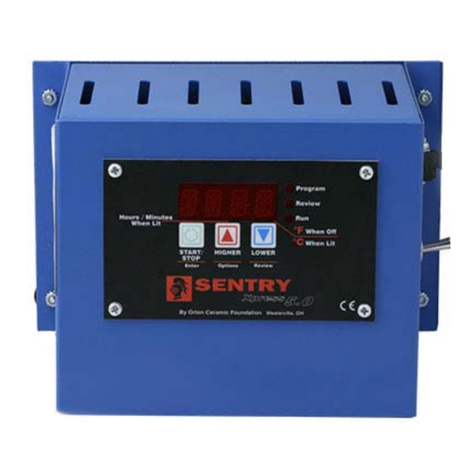
Display Messages
The firing was stopped.
(Page 7) Ready for you to enter an alarm temperature.
When the kiln reaches that temperature, the alarm will sound.
During a User Defined firing, you can change the tar-
get temperature of a segment without having to first stop the
firing.
Fired to completion. If the kiln is already hotter than the
programmed target temperature when you begin firing,
will appear immediately after you begin firing.
(page 3) Delay is a count-down timer that starts the
kiln when the time runs out.
or (and temperature) (page 6) The target
temperature (the temperature that the kiln will fire to). Each seg-
ment in a User Defined program has a target temperature.
Full power firing rate. At this setting the kiln will fire at
its fastest rate. To select Full power, select a rate of
1799°F/999°C at the prompt in a User Defined program. A
fast way to do this is to press the key once from
. will appear.
(pages 5 & 6) Hold time of a segment, shown in hours
and minutes. (i.e. 2 hours 15 minutes = 02.15.)
(Page 7) During a User Defined firing, you can extend
the hold time to a segment without having to first stop the firing.
(page 3) The controller is ready for you to enter a pro-
gram or to begin a repeat firing.
Firing has begun. A moment after appears, you
will hear the relay(s) clicking.
, , , , (page 4)
These are PMC programs stored in memory.
(User Defined Program) (page 5) Select this option to
program a custom firing.
, , etc. (Rate) (page 6) This appears in User
Defined programming for each segment. 1, 2, etc. are segment
numbers. Enter the rate of temperature change for that seg-
ment. Rate is figured in degrees of temperature change per
hour. Example:
A temperature rise of 100° in two hours = 50° rate.
A temperature drop of 200° in one hour = 200° rate.
(Skip Step) (page 5) This message appears when you
press the key during a User Defined firing. If you press
the key again, the firing will skip to the next segment.
The firing was stopped by pressing .
The "Ready to Start" message appears after program-
ming a firing. Press to begin firing. Controller Calibration
(press the ) and Delay (press the )
are accessed from the message.
(Page 9) Calibrate the controller to fire hotter or
cooler.
Trouble Shooter
Problem: Controller display is blank.
No heat in kiln.
IIs the kiln connected to the power?
IHas the circuit breaker tripped or fuse blown?
IIs power reaching the wall receptacle?
Test with a voltmeter or test light if you are not sure.
IHas the kiln switch box ½ amp fuse blown?
The kiln’s ½ amp fuse is lo-
cated in the kiln switch box. Re-
move by pressing the fuse holder
and turning counter-clockwise
half a turn. Check the fuse by
placing the probes of an ohmme-
ter on the ends of the fuse. If the
ohmmeter reads less than an
ohm (digital meter) or reads 0
ohms (analog meter), the fuse is
okay. If the reading is OPEN (digital meter) or infinity/no
needle movement (analog meter), the fuse is bad. Replace-
ment fuse:
AGC 1/2 A 250V AC
IIs the controller receiving power? Test the power IN-
PUT connections on the back of the controller with a
voltmeter.
Controller Power Input Test
Unplug the kiln. Remove the 4
screws holding the controller
faceplate to the switch box. Lift
faceplate out of box and let the
board hang on the box with the
back of the board facing you.
Plug the kiln back in. Touch volt-
meter probes (in AC mode) to
both INPUT connections (the
white and orange wires).
Caution: Do not let the back of the board touch a
grounded object. Make sure the voltmeter is in the
AC mode when placing the probes on INPUT con-
nections.
Controller Power Input Test Result: No voltage
UNPLUG kiln. Check the switch box for disconnected
wires between the cord, transformer, and controller. If wir-
ing is okay, replace the transformer.
Controller Power Input Test Result: 20 - 24 volts AC
Correct current is reaching the board from the trans-
former. But since the board is not lighting up, it is probably
defective. Return the controller for repair or replacement.
Controller Power Input Test Result: less than 20 volts
Did you recently replace the transformer? It may be the
wrong voltage. The voltage is below 20, which is not enough




























